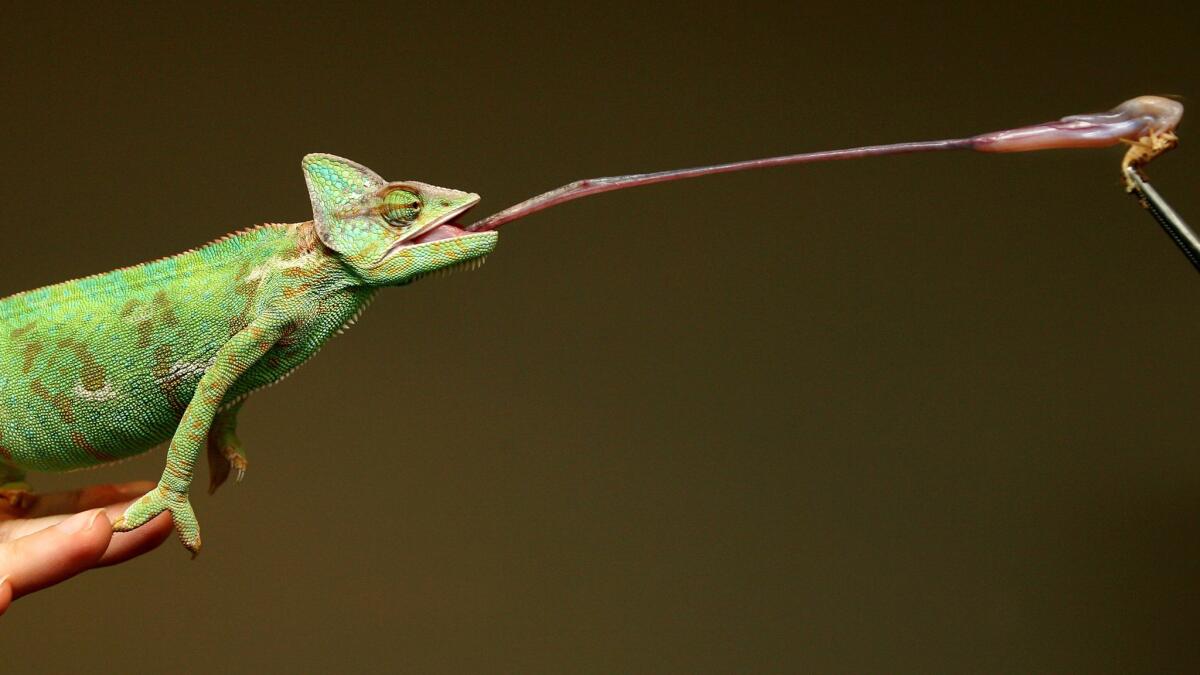Super-sticky saliva helps chameleons catch huge prey, scientists say

- Share via
Imagine holding something that weighs nearly one-third as much as you do — with your tongue. Chameleons execute this impossible-sounding feat before every meal.
Now scientists think they know how the lizards do it. The secret is in the spit, according to a study published this week in the journal Nature Physics.
Biologists have known for some time that chameleons produce mucus in small glands on their tongues, and that it played some role in the capture of insects. But until now, it hasn’t been quantified.
“We want to understand, down to the molecular level, how the system works,” said Kurt Schwenk, a biologist at University of Connecticut who was not involved in the new research. “This is the first study that looks at a very fine scale.”
See the most-read stories in Science this hour »
Scientists found that this super-sticky liquid is about 400 times more viscous than human saliva, and has a consistency similar to honey. This may be what makes it possible for them to grab prey weighing up to 30% as much as they do.
Though it happens in the blink of an eye, the strike and capture of a meal is a finely orchestrated series of events. The front of the chameleon’s tongue protrudes slowly at first. Then the muscles contract, building up energy that packs the punch behind the shot. The acceleration of the tongue in that instant is “larger than that of a fighter jet,” said study author Pascal Damman, a physicist at the University of Mons in Belgium.
After the initial acceleration, the back part of the tongue elongates quickly, unfolding like an accordion as it stretches to reach its target.
“The really unique thing about chameleons is that in this process of capturing prey with the tongue, they add this ballistic phase,” Schwenk said. The tongue “is sailing through the air just based on the power it was given at the beginning, like a cannon ball.”
Then, once the mucus-covered tongue hits the bug, the tongue snaps back like an elastic rubber band.
This is where having a super-sticky tongue comes in handy. Most of the time, chameleon mucus acts like a gooey liquid. But when it’s subjected to a force — like trying to keep an insect attached while reeling backwards at high speed — it hardens and behaves more like a solid layer of glue.
Examining the mucus wasn’t easy. Most viscosity tests require up to 100 milliliters of the sample fluid to come up with an accurate analysis. Chameleons produce a fraction of that — only enough to coat the front of the tongue with a layer of mucus thinner than a piece of paper.
To get samples, they placed a clear microscope slide in front of a tasty cricket, like a window. The chameleon took its best shot at the prey, but wound up hitting the slide instead.
The scientists then set the spit-covered slide at an angle and rolled a tiny steel bead down it. Above the mucus, the bead rolled down freely, thanks to the force of gravity. But once the bead touched the honey-like mucus, drag forces slowed it to a steady crawl — a mere 7 millimeters per second in one trial. The progress of the bead through the mucus gave the researchers all the data they needed to determine the viscosity.
Determining the stickiness of the chameleon tongue has solved one mystery about their ability to capture relatively large prey, but it remains just a piece of the overall puzzle.
There are other factors that contribute to the capture process at different points, Schwenk said. For example, suction through the tongue pores and a Velcro-like process known as interlocking — where tiny clusters of cells on the tongue get tangled with the hairs or antennae of the insect — could both aid with capture.
It’s further proof that with chameleons, there’s much more than meets the eye.
Follow @mdaley on Twitter for more science news and “like” Los Angeles Times Science & Health on Facebook.
MORE IN SCIENCE
To make chocolate healthier and tastier, all you need is an electric beam
Scientists turn plastic bottles and bags into liquid fuel
How running shoes change the muscles in your feet



